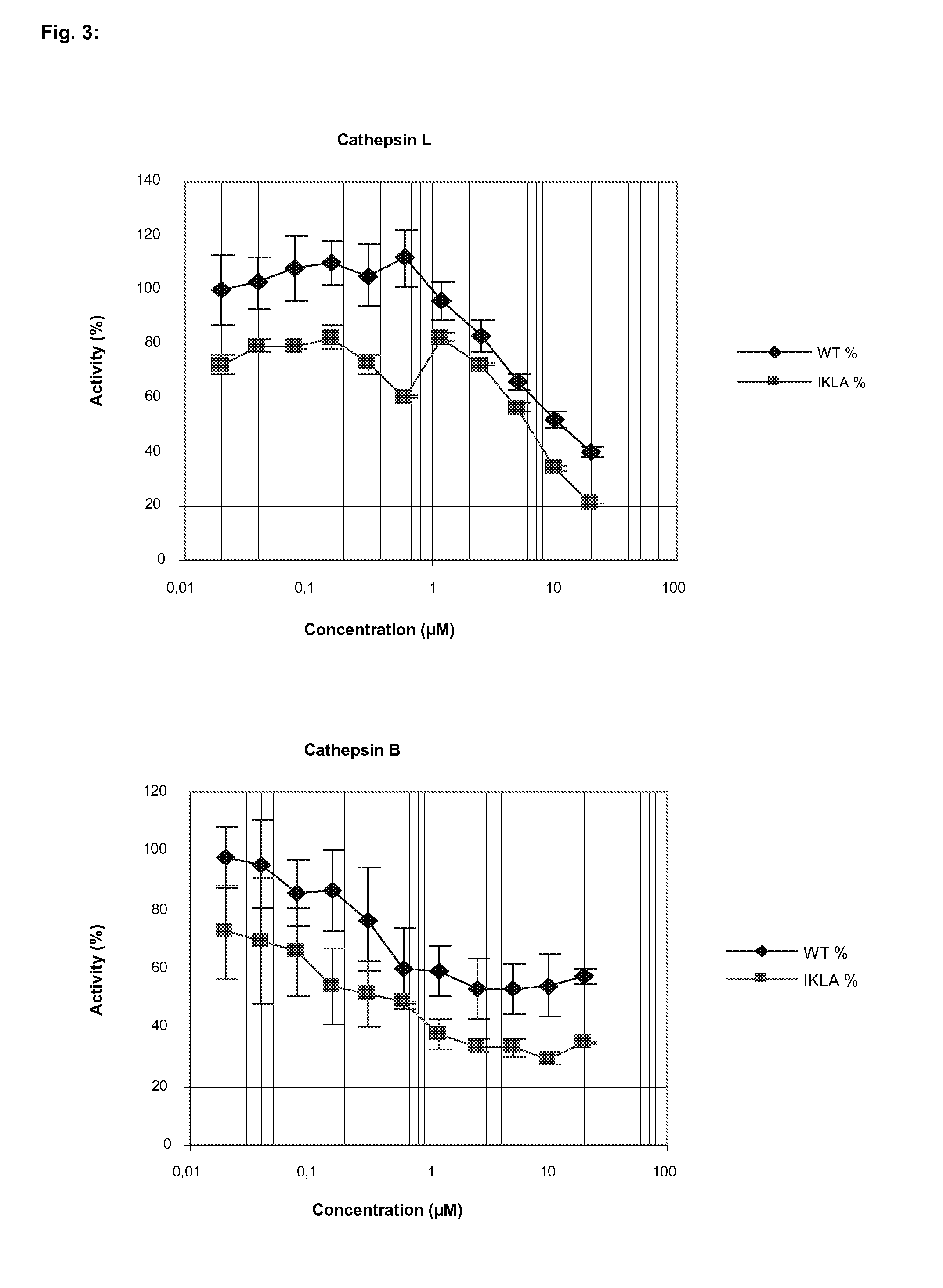Insect inhibiting plant serpin mutants
a technology of insect-inhibiting plant serpin and mutant, which is applied in the direction of biocide, peptide/protein ingredient, peptide source, etc., can solve the problem of damage and yield drop, and achieve the effect of specific resistan
- Summary
- Abstract
- Description
- Claims
- Application Information
AI Technical Summary
Benefits of technology
Problems solved by technology
Method used
Image
Examples
example 1
Inhibition of Enzymes of the Cotton Leafworm, Spodoptera littoralis (Lepidoptera: Noctuidae)
[0058]As shown in FIG. 1, AtSerpin1 exerts a clear inhibition of serine-like trypsin activities already at low concentration with 50% inhibition at about 1 μM concentrations. Maximal inhibition of trypsin activity was scored with ≧10 μM. In contrast, the IKLA (SEQ ID NO:3) mutant did not show potency to inhibit the trypsin protease activities of S. littoralis. Here, fluorometric substrate was employed to measure trypsin activities.
[0059]For chymotrypsin activity inhibition, the concentration of AtSerpin1 needed to inhibit 50% was estimated at 10 μM to 20 μM (FIG. 1). For the IKLA-derived (SEQ ID NO:3) variant of AtSerpin1, its potency to inhibit trypsin activity was lower than the original AtSerpin1, but its activity against chymotrypsin was similar.
[0060]With the use of colorimetric substrates, Table 1 confirms the high potency of AtSerpin1 to inhibit trypsin protease activities from S. litt...
example 2
Inhibition of the Enzymes of the Mediterranean Corn Borer, Sesamia nonagrioides (Lepidoptera: Noctuidae)
[0061]FIG. 2 demonstrates a very strong inhibition by AtSerpin1 of trypsin activities already at low concentration with 50% inhibition at about 0.1 μM concentrations. Maximal inhibition of trypsin activity was scored already with 0.5 μM to 1 μM. The IKLA-derived (SEQ ID NO:3) variant scored low inhibitory activity.
[0062]For chymotrypsin activity inhibition, the concentration of AtSerpin1 needed to inhibit ≧50% was estimated at 0 μM. Interestingly, for the IKLA-derived (SEQ ID NO:3) variant of AtSerpin1, its potency to inhibit chymotrypsin activity was higher than the original AtSerpin1.
[0063]Table 2 clearly provides confirmation of the high potency of AtSerpin1 to inhibit trypsin protease activities from S. nonagrioides extracts. With the derived IKLA (SEQ ID NO:3) variant, the activity was lost. The tests for inhibition of chymotrypsin activities with AtSerpin1 showed no activity...
example 3
Inhibition of the Enzymes of the European Corn Borer, Ostrinia nubilalis (Lepidoptera: Crambidae)
[0064]With use of colorimetric substrates for trypsin and chymotrypsin activities, AtSerpin1 shows limited potency to inhibit trypsin protease activities from O. nubilalis extracts with 28% at 2 μM (Table 3). With the derived IKLA (SEQ ID NO:3) variant, the activity was much higher reaching 51% inhibition at 2 μM. The tests for inhibition of chymotrypsin activities with AtSerpin1 showed no activity, whereas the mutant IKLA (SEQ ID NO:3) exerted 21% inhibition at 2 μM.
TABLE 3Inhibition of serine-like protease activities fromO. nubilalis extracts by AtSerpin1 and itsderived variant IKLA (SEQ ID NO: 3).% InhibitionTrypsinElastase2 μM2 μMAtSerpin128 ± 2niMutant IKLA (SEQ ID NO: 3)51 ± 121 ± 1ni = no inhibition
PUM
 Login to View More
Login to View More Abstract
Description
Claims
Application Information
 Login to View More
Login to View More - R&D
- Intellectual Property
- Life Sciences
- Materials
- Tech Scout
- Unparalleled Data Quality
- Higher Quality Content
- 60% Fewer Hallucinations
Browse by: Latest US Patents, China's latest patents, Technical Efficacy Thesaurus, Application Domain, Technology Topic, Popular Technical Reports.
© 2025 PatSnap. All rights reserved.Legal|Privacy policy|Modern Slavery Act Transparency Statement|Sitemap|About US| Contact US: help@patsnap.com



